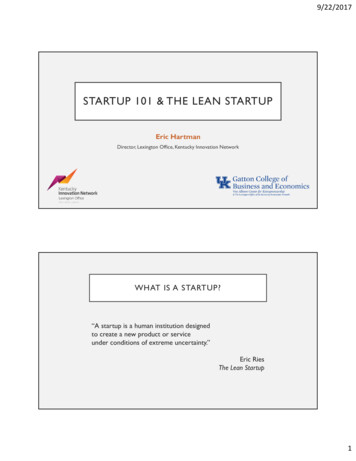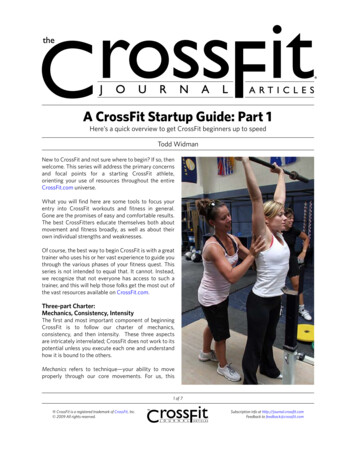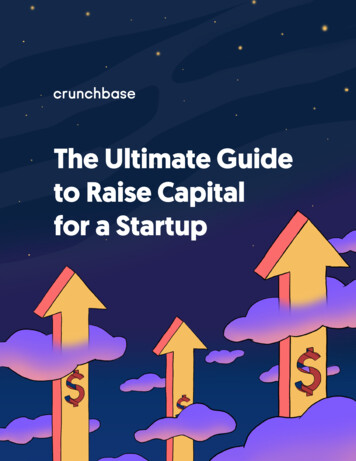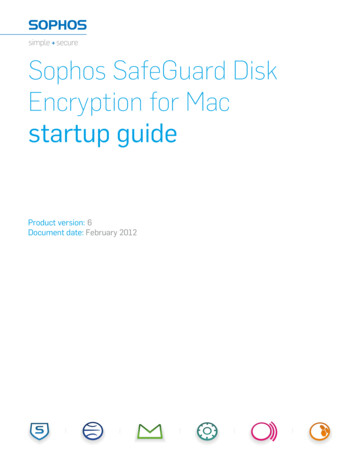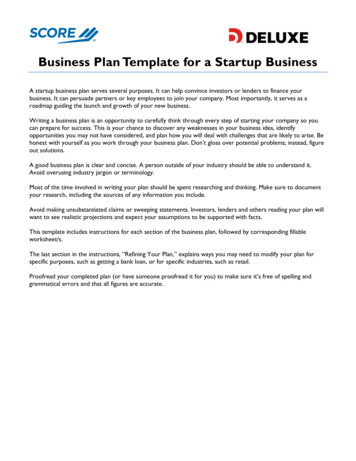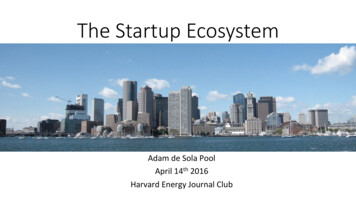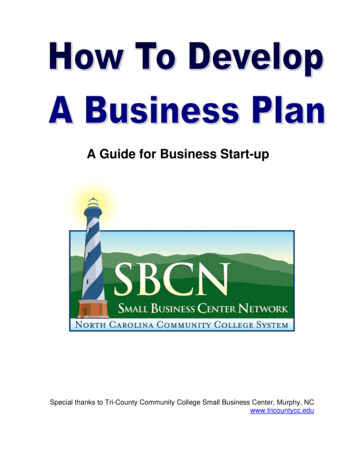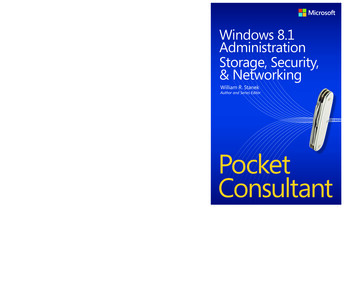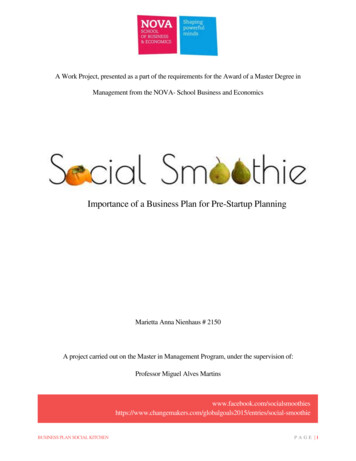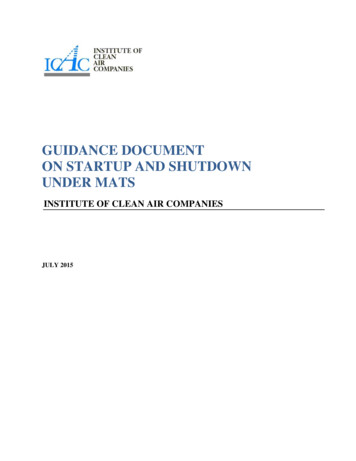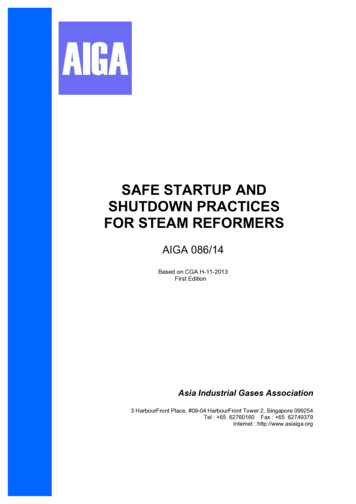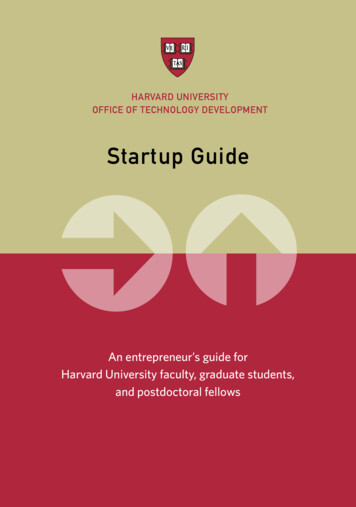
Transcription
HARVARD UNIVERSITYOFFICE OF TECHNOLOGY DEVELOPMENTStartup GuideAn entrepreneur’s guide forHarvard University faculty, graduate students,and postdoctoral fellows
TABLE OF CONTENTSWhy Start a Company?2Key Considerations5Startup Process6Funding Sources7Presenting to Investors8Financing Terminology10Company Considerations13Equity Considerations14Some Resources for Entrepreneurs15Key Factors for Success16
We have created this handbook to serve as a high-level guide and overview of somekey questions and issues that may confront you, the aspiring entrepreneur, as you beginyour quest to start a new company around innovations emanating from your lab.Its purpose is not to supply all the answers, but rather to provide a starting point forengaging you in a conversation with the Office of Technology Development (OTD)about your entrepreneurial journey.OTD works closely with Harvard faculty, graduate students, and postdoctoral fellowsto explore the potential of forming startup companies around new inventions andplatform technologies arising from their research. Creating a startup company, alsoknown as a NewCo, is a viable and often attractive alternative to working with anestablished company. A NewCo can expedite the development and commercializationof nascent technologies that satisfy unmet market needs and benefit the public good.OTD has the entrepreneurial expertise to guide Harvard investigators through thechallenging process of organizing and starting a new company. Our team members haveextensive experience catalyzing and forming early-stage startup ventures, havingfounded and secured funding for such companies, and have participated in successfulcompany exits.I hope that you will make OTD your partner in pursuing your entrepreneurial vision: weare eager to be your sounding board, to address your questions, and to guide youthrough the process of launching a new company. Please take the next step and stop byOTD anytime to discuss your startup ideas. We encourage you to explore the potentialof entrepreneurship and become part of Harvard’s expanding startup ecosystem.Isaac T. KohlbergSenior Associate ProvostChief Technology Development Officer1
Why Start a Company?When launching a new company, there are anumber of factors to take into consideration.The reality is that only some inventions maybe suitable for the creation of a startupcompany. Innovations may progress morequickly in a focused startup than in anacademic lab or a large company. Along withthe invention team, OTD helps in analyzingseveral factors to determine whether astartup is the most appropriate path tocommercialization: Demand: Potential of the core technologyto provide a solid platform for multiplemarkets or product opportunities. Competition: Identification of othercompanies that offer similar solutions. Licensing: Likelihood of interest fromexisting companies in licensing thetechnology. Funding: Availability of capital to buildand grow the business, together withthe interest, capabilities, and track recordof likely investors. Commitment: Level of commitment andinvolvement of the inventors. Support: Presence of a true businesschampion for both the technology andthe new venture. Management: Experience, passion, anddrive of the startup’s executive team.OFFICE OF TECHNOLOGY DEVELOPMENTOUR MISSIONOTD’s mission is to make the fruits of Harvard research more accessible outside theUniversity, including underserved communities, and to ensure that society benefits fromHarvard innovations by fostering their swift, professional, and effective developmentand commercialization.To this end, OTD seeks to foster a spirit of innovation and entrepreneurship among thefaculty, harness the power of Harvard’s substantive intellectual property, and advance thedevelopment of new discoveries made by the faculty for the good of society. Aspects ofour mission relevant to starting new companies include:Promoting Innovation and EntrepreneurshipEncouraging innovation and accelerating technology transfer in a manner consistentwith Harvard’s tradition of academic independence, public service, and commitmentto the community.Protecting and Harnessing Intellectual PropertyEvaluating, patenting, licensing, and, when appropriate, creating startup companiesaround new inventions and discoveries made by Harvard’s faculty.2
“OTD’s knowledge of what it takes to start a company isbased on firsthand experience and was vital to our abilityto get our NewCo off the ground. They were with us everystep of the way, offering valuable guidance and feedback.”— G Ö k H an S . H ota m isligilJ.S. Simmons Professor of Genetics and MetabolismChair, Department of Genetics and Complex DiseasesHarvard School of Public Health3
“OTD was masterful in the initiation phase of thelicensing process. Even more important, as ourresearch progressed, they developed packages fora follow-on license that enabled the company tosecure a major strategic corporate partnership.”— G r ego ry L . V e r dineErving Professor of ChemistryDepartment of Stem Cell and Regenerative BiologyHarvard Faculty of Arts and Sciences4
Key ConsiderationsBelow are items to consider when deciding whether or not to start a NewCo:1Is the invention a disruptive technology?If not, how would it be categorized?The valuations are based on severalfactors, including:2 How soon can a commercial productcome to market? In what stage of development is thetechnology?3 What is the level of risk associated withthis startup? Is there proof-of-concept lab data?4 Does the technology have clearapplications and a definable market? Are there paying customers?5 Who owns the intellectual property(IP)? For more information, referto OTD’s Inventor’s Handbook andHarvard’s IP policies.6 What will be my role in the new company: full–time employee, advisory boardmember, executive, or consultant?7 What are the goals for the company?Is it to grow the company and position itfor an acquisition or a possible initialpublic offering (IPO)? Or, is it to build asmall, yet sustainable business?8 Will capital from private investmentcompanies be needed? If so, will thecompany eventually be sold or gopublic? Private investors rely on theseexit strategies to get a return on theirinvestments.9 What is the current value of the company? Pre-money valuations (valuationof a company prior to an investment)of early-stage companies are generallyin the 1–3 million range. Is there a working prototype?OTD can help navigate these considerations.However, we strongly recommend speakingwith external advisors or mentors who canprovide additional perspectives and guidance.Once IP protection is in place, talk aboutyour ideas (with a confidentiality agreementin place, when appropriate); the morefeedback you receive, the higher the likelihood of success.Talk to potential customers. The informationobtained by asking questions will providecritical feedback that not only will increaseconfidence in the startup’s potential, butalso will enhance the likelihood of receivingfunding and, ultimately, the success ofthe venture. Who are your customers? What do they care about? Can the company’s product(s) solvetheir problems? How are they currently addressingthe problems? How does the technology solve theirproblems in a unique way? How large is the market? How much are they willing to pay fora solution?5
Startup Process: Six Steps to Launch61CONTACT OTD2PROTECT INTELLECTUAL PROPERTY3SEEK INPUT AND NETWORK4PLAN THE BUSINESS5NEGOTIATE THE LICENSE OR OPTION AGREEMENT6PURSUE FUNDINGDiscuss your invention and how to protect the intellectual property to decidewhether a startup company is a suitable option.Work with OTD to file a patent application on the invention before it comes public.A major asset of a startup company is its intellectual property. After publicdisclosure, obtaining a patent, particularly outside the United States , may nolonger be possible.Identify a mentor and work with him or her regularly, network with like-mindedentrepreneurs, review ideas with potential investors, and evaluate the commercialaspects with potential customers. OTD provides the resources to get started.Develop an understanding of the market potential, competition, funding needs,and path to productization and profitability. OTD’s expertise is useful in providingguidance on competitive analysis, market assessment, and business planning.Obtain a license or option agreement from Harvard to demonstrate to potentialinvestors that the company has secured the rights to the technology. OTD leadsthese negotiations along with an officer of the company.Commercializing technology typically requires external capital. Introduce thecompany to venture capitalists, angel investors, and, perhaps, friends and family.OTD assists in making connections with entrepreneurs, angel investors, andventure capitalists.
Funding SourcesWhen starting a company, generating fundingto support the business is perhaps the singlemost important task at hand. Before embarking, it is necessary to determine how muchfunding is required and from where it willcome. Here are some factors to consider indetermining how much funding is necessary: Time to market (that is, how long beforeinitial sales) Employee salaries and benefits Space Equipment Travel Legal feesFunding for the company may come fromone or more sources, including sales, grants,and investors. For example:Organic Growth: Grow the business slowlybased on sales, without the need to raiseexternal funds. Organic growth can bea reasonable strategy for certain NewCoventures. Typically, however, universityinnovations are at such an early stageof development that additional fundsare necessary to move them from the labto market.Friends and Family: It may be possible tosecure a small amount of funding fromfriends and family to launch the businesswhile additional funding is sought.Small Business Innovation Research(SBIR): Apply for research grants. The U.S.government provides innovation researchgrants to small companies, which can begreat sources of initial capital. SBIR grantscan only be provided to a company, notdirectly to an academic lab. For moreinformation, visit www.sbir.gov.Angel Investors: Individuals or groups thatinvest their own money in early-stagecompanies. New England has a number ofangel investor groups, including Launchpad,CommonAngels, Hub Angels, and BostonHarbor Angels. For a listing of angel groups inthe region as well as other useful information,visit www.angelcapitalassociation.org/directory.Venture Capitalists: Venture capital firmsmanage and invest the funds of otherinvestors. OTD is familiar with venturecapitalists in New England and beyond, andcan help to establish connections withinthese firms. More information can be foundat www.newenglandvc.org.STARTUP SUCCESS STORY: Tetraphase PharmaceuticalsIn 2005, Dr. Andrew Myers and colleagues in Harvard’s Department of Chemistry andChemical Biology published results of their research on new classes of antibiotics aimedat drug-resistant infections. OTD worked closely with Dr. Myers to actively evaluate andpursue multiple commercialization alternatives. Extensive market, IP, and competitiveanalyses were completed, leading OTD to initiate early development plans for a NewCo,including the commercialization strategy and the assembly of an initial investor syndicate.The efforts of OTD led to the launch of Tetraphase Pharmaceuticals in 2006 with 25 millionSeries A financing to capitalize on this groundbreaking technology from Dr. Myers.7
Presenting to InvestorsPresenting the idea along with the supportingresearch to investors is an important step inthe startup process, and one that requiresthorough preparation. When scheduling ameeting with an investor, be very clear aboutits purpose. An informational or exploratorymeeting may be acceptable, but be sure thatthe investor understands that this is theintent of the meeting. If the purpose of themeeting is to request funding, and thepresentation team is not properly prepared,then subsequent meetings (and funding) areunlikely. Include the following informationin the company pitch: What problem does the technologyaddress? How does the technology providea solution? What market is being pursued?What is the addressable market? Do notinflate data; if the idea is for a particularmarket segment, provide data for thatsegment only.- Market size- Target customer- Market segment What is the state of the intellectualproperty? Is the technology wellprotected? Will IP be needed fromother sources? Who is the competition? Investors expectthat there is competition in every marketarea; claims of no competition aregenerally met with disbelief. What is thecompetitive advantage? Why wouldcustomers prefer the product or solutionbeing offered over another? Who is on the executive team, and whatare their roles? Why should someoneinvest in this team? How does the business model relateto the sales strategy and pricing? What are the expense and revenueprojections for a five-year period? What are the key company milestones? How much money is being requested?How long will it last? How will the fundsbe spent?The presentation should be interesting andengaging. Tell a story and use examples.If potential customers or partners haveprovided feedback, include examples.STARTUP SUCCESS STORY: Diagnostics For All (DFA)DFA is a not-for-profit organization established to translate early-stage technologiesdeveloped in the lab of Dr. George Whitesides of Harvard’s Department of Chemistryand Chemical Biology. DFA’s efforts will introduce innovative, affordable, and effectivepoint-of-care diagnostic solutions to medical problems in the developing world. HonoringOTD’s and Harvard’s commitment to the principles of socially responsible licensing, OTDformed a collaborative and supportive relationship with DFA. This relationship representsa new paradigm for how a university can fulfill its public service mission by facilitating therapid and specific maturation of innovation for deployment in the global health arena.8
“OTD negotiated a fair and reasonable licensingagreement with the NewCo that formed out of mylab. They were extremely helpful to us both in theinitial stages of forming a company and beyond.”— A nd r ew G . My e r sAmory Houghton Professor of Chemistry and Chemical BiologyDepartment of Chemistry and Chemical BiologyHarvard Faculty of Arts and Sciences9
Financing TerminologyEquity: The ownership interest of the company that is held by various parties.Initially, the founders typically own 100 percent of the company. A licenseagreement with Harvard and equity financing (in which someone providesfunding in exchange for a percentage of the company) often occur earlyin the formation of a NewCo. At that time, the owners of the equity are thefounders, the investors, and Harvard. The investor group will typically want40 to 60 percent of the company, though the percentages can vary basedon a number of factors, and may be less for individual investors.Ownership compared to control: Equity investors are generally in control of thecompany. Provisions in the investment documents usually give the investorsauthority over certain decisions, such as whether to accept an acquisition offer,even if they have less than 50 percent of the outstanding shares. After a firstround of financing, the founders’ total equity percentage is often “diluted” toless than 50 percent.Option pool: A percentage of stock options set aside for special purposes.Sometimes, investors require that about 20 percent of the company’s optionsbe reserved to attract key employees.Pre- and post-money valuation: The company’s pre-money valuation is itsvalue before an investment is made. Pre-money valuation must be reasonable.Post-money valuation is the pre-money valuation plus the amount invested.For example, if investors provide 3 million and the pre-money valuationis 2 million, the post-money valuation is 5 million. In this example, theinvestors have 60 percent of the equity.Convertible debt: Funding that can be converted into shares at a later fundinground. Sometimes convertible debt is a good funding alternative. However, thecompany immediately has debt on the balance sheet, and a valuation still mustbe set in case additional funding rounds are not needed.10
Preferred shares compared to common shares: Investors typically takepreferred shares, and the founders and employees hold common shares.Preferred shareholders may have additional rights. For example, preferredshareholders have the right to get a multiple of their investments back(often one times the amount, but it can be higher) before any distributionto other shareholders. This can be illustrated with a simple example in whichthe preferred shareholders (investors) invested 5 million, they hold 50 percentof the equity, have a 1X preference, and the startup is sold for 25 million.In this case, the investors will first get 5 million, and then the remaining 20 million is split according to the equity percentage of the shareholders: 10 million to the investors, and 10 million to the common shareholders.Anti-dilution: Protection against future financing when the value of thecompany decreases (also referred to as a down-round). Anti-dilution ensuresthat equity stakes do not drop below a certain percentage. The most commonis weighted average anti-dilution. Full ratchet protection may also be used attimes, and provides investors with the highest level of protection.Only some of the provisions and terminology of a financing term sheet arereferenced here, and these are not necessarily fully defined. More in-depthlistings, definitions, descriptions, and sample term sheets can be found on theInternet. A mentor who is a seasoned entrepreneur is also an excellent sourceof guidance. When negotiating a term sheet with investors, the company’sprincipals should hire an attorney with relevant experience to represent them.11
“OTD’s understanding of and insight into theformation of startup ventures were key to thesuccessful formation and launch of our company.”— David A . W eit zMallinckrodt Professor of Physics and of Applied PhysicsHarvard School of Engineering and Applied Sciences12
Company ConsiderationsLegal representation: OTD is not in aposition to provide legal advice, nor doesthis document purport to lend legal advice.Seeking counsel may be of great benefit inmaking the various decisions related tostarting a company. An attorney withexperience in business entity formationand equity considerations can be a reliableand trusted advisor.Type of company: When incorporating,choose among an S-Corp, C-Corp, orLimited Liability Company (LLC). Companiesthat plan to take an equity investmentshould generally be established as aDelaware C-Corp.Board of directors and the advisory board:Establish an advisory board early in thelaunch process. An advisory board should bethree to four people who can provideguidance in areas with which the foundersare not familiar; for example, raising money,hiring, sales, product development, andmanufacturing. A board of directors shouldinclude one individual from the company,one or more investors, and independentindustry representatives.Management team: Consider each founder’srole in the management team. Generally, afaculty member will have an advisory boardrole, and a postdoctoral or PhD student maybe the chief technology officer or the vicepresident of research and development.Other team members may be needed withstrong domain expertise, sales experience,and marketing know-how. Investors areusually interested in a company with astrong management team; they are unlikelyto fund even the best ideas if the right teamis not in place.Space, insurance, and payroll: Makedecisions about workspace, insurance, andpayroll right away so that the team canconcentrate on building the product andthe business. Consider hiring an operationsperson or an assistant to manage theseitems, renting shared office space, andoutsourcing payroll.STARTUP SUCCESS STORY: Crimson Hexagon, Inc.Crimson Hexagon was established to develop and commercialize a novel algorithmdeveloped by Dr. Gary King in Harvard’s Department of Government in the Faculty ofArts and Sciences. Dr. King’s technology for sentiment analysis is an innovative meansof gleaning opinions from unstructured text in ways that surpass existing approaches.Initially developed to determine sentiment on blogs about presidential candidates, its keymarketable application is for companies to: Learn more about common perceptions of their products Receive real-time, ongoing information related to what is being written Understand the opinions and sentiments of their customer baseOTD worked closely with Dr. King to develop the initial business strategy of the company.The initial funding for the company came from an angel investors group that OTD introducedto the company’s founding CEO.13
Equity ConsiderationsWhen starting a company, the co-foundersshould agree about how to split the equity.A conversation of this nature should takeplace early in the process, and agreementshould be formalized. Is the contribution ofeach founder equal? Is the risk the same foreach founder? For example, is one founderleaving a job to work full-time and unpaidat the company, while another is continuingin his or her current job until the startup isable to raise money?It is also important to consider reversevesting, where each founder’s equitypercentage becomes available over time.If all the founders get all of their equity onday one, and six months later one founderleaves while other founders continue to workfor several more years, the equity will not befairly distributed. Reverse vesting allows anindividual to receive stock immediately,which may be beneficial for tax reasons, butstill maintains vesting requirements, such aslength of employment, to be met.Consider if equity can and should be used topay for outside services. Legal counsel,marketing, and accounting professionalsmay take equity in lieu of cash. This typeof payment may seem useful before moneyhas been raised, but take note — it can beextremely difficult to establish a fair amountof equity in exchange for such services.How much equity should be set aside forthe advisory board and for the board ofdirectors? Typical amounts are one-quarterto one-half percent for advisory boardmembers, and one-half to one percentfor directors.There are personal tax implications forfounders, depending on how equity isgranted. It is vital that you get legal adviceon these tax implications before incorporating the company and issuing shares. Chooselegal counsel that has experience workingwith startup companies.Harvard expects equity and other consideration, including royalties, in exchange for alicense to the IP. This equity is a minorityposition and can include anti-dilutionprovisions. Harvard does not invest moneydirectly in startup companies.STARTUP SUCCESS STORY: GnuBIO, Inc.Dr. David A. Weitz of Harvard’s School of Engineering and Applied Sciences is aworld-renowned expert in microfluidics and emulsions. His research led to the applicationof techniques in the field of DNA sequencing. Already a seasoned entrepreneur, Dr. Weitzapproached OTD about starting a new company to commercialize his latest innovations.GnuBIO, Inc., was launched in 2010 to develop this next-generation sequencing technology for the molecular diagnostic and applied research markets. Working closely withDr. Weitz and the GnuBIO founding team, OTD made introductions to potential investors,advised the team on an appropriate capital structure, provided guidance on a fair distribution of equity, and worked collaboratively with all parties to ensure a smooth and efficientnegotiation of the license terms.14
Some Resources for EntrepreneursAt HarvardAround New EnglandOTD: The Office of Technology Developmentis responsible for Harvard-owned intellectualproperty and takes an active role in workingwith faculty, graduate students, and postdoctoral entrepreneurs within the Harvardcommunity.MIT Enterprise Forum: A forum that offersnumerous events for entrepreneurs aroundNew England (no affiliation with MIT isrequired).TECH: The Technology and EntrepreneurshipCenter at Harvard works with undergraduate students to support and encourage theirentrepreneurial ideas, and runs an annualbusiness plan competition.HBS Entrepreneurship Center: The ArthurRock Center for Entrepreneurship at HarvardBusiness School is a resource for HBSstudents interested in company formation.Harvard Innovation Lab: Launched in 2011,the Innovation Lab is a resource for studententrepreneurs throughout the Harvardcommunity.Harvard Startups: A Yahoo! group thatprovides resources for entrepreneurs andbusiness individuals to post questions,information, jobs, and more. Mainly targetedat Harvard alumni.Commercializing Science and HighTechnology: An HBS class that is opento students throughout the University,one of several such entrepreneurial classesat Harvard. Student teams work oncommercialization strategies for Harvardresearch lab technologies.Cambridge Innovation Center: One ofseveral places that provide shared officespace for early-stage companies.TechStars: A mentorship-driven seed-stageinvestment program that runs in Boston andother cities.Dogpatch Labs: Created by Polaris VenturePartners to connect entrepreneurs and helpfounders conceive and launch startups.Betaspring: A mentorship-driven startupaccelerator program for technology anddesign entrepreneurs based in Providence, RI.BlogsNumerous blogs exist that are great sourcesof information for the aspiring entrepreneur.Browse the selection below for an introduction to the ever-growing blogging world. .com15
Key Factors for SuccessThis guide provides an overview of the startup process and the relevant aspects of startinga business. Of course, there are many additional sources of information. However, OTD is agood place to start — our team can provide sound advice and guidance.Be sure to: Obtain trusted advice and mentorship.Talk to customers.Bring on the right team members.Be passionate.Prepare a one-minute elevator pitch that will grab someone’s attention and motivatehim or her to ask for more information. Practice the company pitch. Network with other entrepreneurs and representatives in the industry.OTD can: Provide an initial sounding board for exploring startup ideas.Protect the intellectual property that is the foundation of the new company.Make introductions to entrepreneurs, angel investors, and venture capitalists.Provide assistance with business planning.Assist you on competitive analysis, market assessment, and investor pitches.Harvard University Office of Technology Developmentwww.otd.harvard.eduIn CambridgeIn Longwood(617) 495-3067(617) 495-9568 fax(617) 432-0920(617) 432-2788 faxHolyoke Center Suite 727E1350 Massachusetts AvenueCambridge, MA 02138 USAGordon Hall Suite 41425 Shattuck StreetBoston, MA 02115 USA16
These logos represent a few of the many Harvard startups that OTD has helped launch.QSTREAM
Harvard University Office of Technology Developmentwww.otd.harvard.eduIn CambridgeIn Longwood(617) 495-3067(617) 495-9568 fax(617) 432-0920(617) 432-2788 faxHolyoke Center Suite 727E1350 Massachusetts AvenueCambridge, MA 02138 USAGordon Hall Suite 41425 Shattuck StreetBoston, MA 02115 USACopyright 2011 The President and Fellows of Harvard College
and grow the business, together with the interest, capabilities, and track record of likely investors. Commitment: Level of commitment and involvement of the inventors. Support: Presence of a true business champion for both the technology and the new venture. Management: Experi
